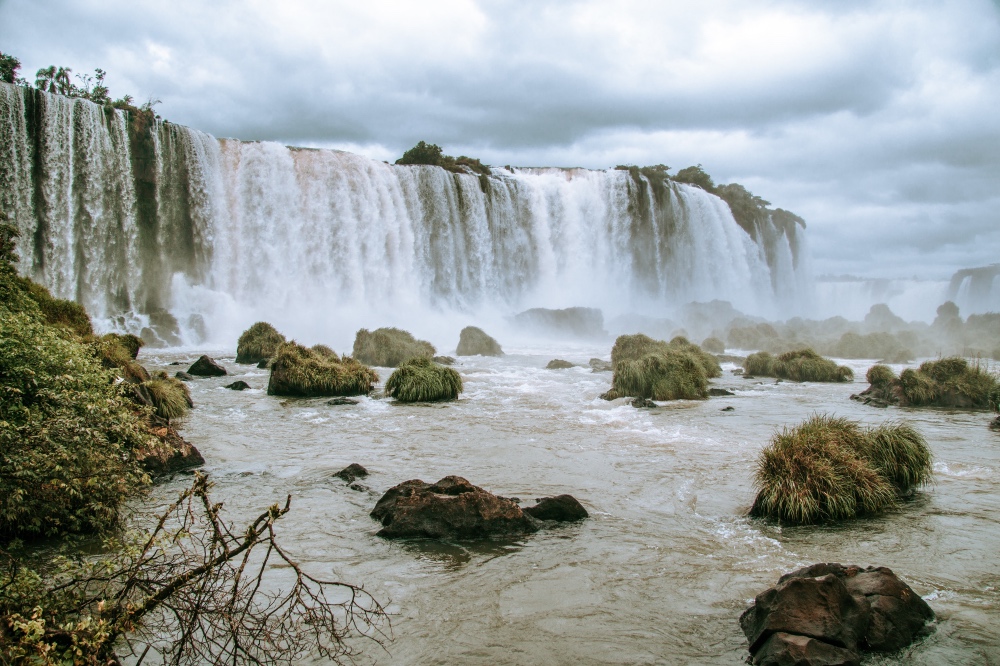Buenos Aires
Thomson Reuters Foundation
At Iguazu Falls, a World Heritage site and one of South America’s tourist highlights, crowds normally gather in the drifting spray of 275 spectacular waterfalls, spread in an arc around them on the border between Argentina and Brazil.
Last month, however, it’s not just the coronavirus pandemic that has closed the famed attraction. A strengthening drought that threatens much of southern South America has reduced the once-mighty falls to slender rivulets.
The Iguazu River, which feeds the falls, is running at just 13 per cent of its usual flow, according to Iguazu National Park officials.

The Iguazu Falls in better times. PICTURE: Diego Rezende/Unsplash
The nearby Parana River, similarly, is at its lowest level in 50 years, leaving ships stranded, hydropower production slashed and government officials in northeast Argentina worrying about whether water for drinking and hand-washing will hold out during the COVID-19 pandemic.
Little new rain is expected for months.
“The rainy season in Brazil, which runs from December to April, is ending and it has hardly rained,” said Gustavo Villa Uría, an under-secretary for public waterworks in Argentina’s government.
Climate change “likely” is playing a role in the changes, and deforestation in southern Brazil “has an undeniable effect”, he told the Thomson Reuters Foundation.
Forests – including Brazil’s Amazon – release water vapour that in South America travels toward the agricultural heartlands of southern Brazil and Argentina and falls as rain, scientists say.
With deforestation surging in Brazil, as President Jair Bolsonaro encourages development of the Amazon, water is expected to become in increasingly shorter supply in the region, they say.
Juan Rivera, an Argentine drought expert and member of the Intergovernmental Panel on Climate Change, agreed the Parana River has seen a greater variability in its flow over decades, including more flooding as well as droughts.
Bottled water
For now, lack of water is a big problem for towns like Puerto Iguazu, where authorities have had to hand out bottled water since March after the community’s water intakes ran dry.
Some residents in the town of 45,000 are sourcing water by hauling tanks to three local wells opened for free public use.
“We have a chronic shortage problem here due to lack of infrastructure investment and it is aggravated by prolonged drought,” José Barrios, president of Amigos de los Parques Foundation of Puerto Iguazu told the Thomson Reuters Foundation.
Throughout the region, water scarcity amid of the COVID-19 pandemic is causing “great concern” to authorities, Villa Uría admitted.
Low stream levels have halved electricity production at the Yacyretá and Salto Grande hydroelectric dams since March – a situation eased only by the fact that many industries have been shuttered in response to the coronavirus pandemic.
Cecilia Britto, a legislator from Argentina’s Misiones province, one of those hardest hit, blamed the drought on “deforestation and global warming” – but said Brazil was also carefully managing its water supplies “at the expense of downstream peoples”.
She and other officials in northeast Argentina asked their country’s government to work with Brazil to release more water from dams along the Iguazu River.
Villa Uría said Brazil had stepped up water flowing from the Baixo Iguazu dam on the river through the end of April and would boost the amount of water released from Itaipu, the world’s largest hydroelectric producer, as well.
But Juan Borus, a hydrological engineer with Argentina’s National Institute of Water, told local media that the changes were not yet sufficient to relieve drought pressure on water supplies.
Rivera, an atmospheric scientist, said that if worsening droughts are a result of deforestation or other changes in land use, the region would need to develop better tools to predict them, and try to issue early warnings “to be better prepared”.






